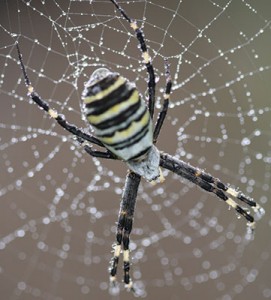
This banded garden spider (Argiope trifasciata) is commonly found in gardens, so if she’s indoors, look for vegetation that might be causing her to set up housekeeping there. Photo: ©istock.com/kgfot
The first step in an integrated pest management (IPM)-based solution is, of course, to identify the pest. What is it, where is it, why is it? If we pay attention, the pest will tell us the answer to these three questions.
Let’s look at the way three common groups of pests “talk” to us.
Spiders
One of the common pests around the globe that we’re asked to control is the spider, which can be difficult to control unless we listen to them.
Spiders typically live where they have a food source — insects, in most cases. Where the web is constructed, then, will tell us not only where the food source is, but in some cases what the food source is (by examining the contents caught in the web).
Let’s examine this a bit more:
- A web built at the floor level tells us the food source for this spider is a crawling insect of some type. It will also say that the location of the insects is very close to the web, so the spider can easily capture them.
- A web constructed high around the ceiling could indicate that the food source is nighttime flying insects.
- A web halfway up a wall could indicate daytime flying insects.
- Webs located within warehouse rack systems could indicate a stored product insect infestation of some type.
In many cases, spider control can be as easy as controlling the food sources. Let the spider tell you what it is eating. Remove that, and you will often remove the spider.
Cockroaches
Spiders are not the only pests that communicate with us. Cockroaches will tell us about their population and what phase of control you are in by what appears on a monitor trap.
I think everyone can figure out that if roaches are on the left side of the monitoring trap, the harborage is someplace on that side of the trap. What many professionals miss, however, is the life stage of the caught roaches and what implications that has for treatment. If the trap has adult males and a few nymphs in it, that indicates a newly introduced population. Traps with a high number of nymphs and a few adults, on the other hand, would indicate an established infestation that has reached the point of overcrowding.
Flies
The type of fly caught in an insect light trap (ILT) will tell you what the breeding source could be. Remove the breeding source and you provide one of the most important steps in fly management. Stored product pests caught in the traps will point you to what product is infested. Now your challenge is simply to find them.
Of course, none of these communications will matter if you don’t understand the pest. Know your pest, control your pest. Misreading these signs or communications from the pest can be a disaster.
You can reach Frank Meek, international technical and training director for Orkin, at fmeek@rollins.com.
Leave A Comment